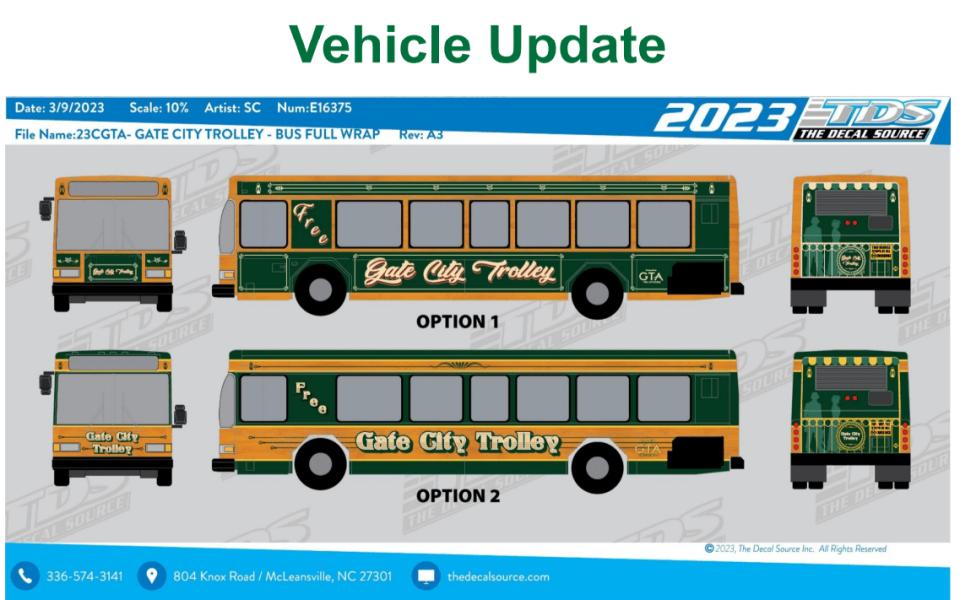Featured photo: Mockups of what the Greensboro trolleys could look like (screenshot)
This July, there will be a new way to get around Greensboro.
During a city council work session on March 28, councilmembers and transit officials came together to discuss plans for a trolley pilot program in the city.
The program shifted into gear in 2019 when it received funding as a participatory budgeting project — a process where members of the community vote on how a portion of the city’s budget will be spent. The project accumulated $18,000 from each of the five districts for a grand total of $90,000.
“Then COVID hit and the project went dormant,” said city transit planner Gray Johnston.
Johnston added that the project was reignited after City Manager Taiwo Jaiyeoba was instated.
An additional $1 million in American Rescue Plan Act funding will also be used for the project after the council passed a resolution authorizing funding for ARPA-enabled projects in January.
Jaiyeoba mentioned that this funding would help the project go beyond what could originally be done with just the initial $90,000.
“Thanks to y’all, there’s a bigger budget to actually figure out what we could do with this project,” Johnston noted during the presentation.
The pilot program will utilize retired buses that would have been sold. Instead of getting rid of them, the old buses will be retrofitted with new engines and repurposed as trolleys. The trolley service will be free, and will use four dedicated buses.
Johnston said that in order to make the buses look like old trolleys, modifications such as new seat covers and LED lights will also be added. They will differ from trolleybuses because they will not be powered by overhead power lines.
In mock-ups for how the trolleys will look, the vehicles are emblazoned with the moniker Gate City Trolley, however Johnston said this will not necessarily be the name of the trolley, adding that the team has considered doing a “public naming campaign so that the citizens can vote on the actual name of the service.”
Where might the trolleys run?
Johnston presented councilmembers with three route options, all beginning downtown at South Elm Street. The first route serves downtown, connecting South Elm Street to North Elm Street with 5-7 minute wait times, while the second route would have 7-10 minute wait times and take riders to Moses Cone Hospital and other healthcare access points. The third option would connect downtown to Revolution Mill, with fewer stops and wait times increasing to 15-20 minutes.
“Each of these options has its pros and cons, and kind of changes the feel of what we’re going after,” Johnston said.



Johnston also mentioned that a few city bus routes already service these areas, such as route 3 along Church Street, route 6 along Summit Avenue and route 15 along Yanceyville Street.
“Ultimately, we just wanted to have you all give us feedback about what you think the goals of this trolley are,” Johnston said to the council.
District 5 representative Tammi Thurm shared her thoughts, leaning toward the shortest route. “We can always expand the service if we’ve got great results and the citizens love it,” she said.
Thurm noted that if wait times for a trolley are around 20 minutes, “people are gonna start getting impatient and want to take their cars anyway.”
“In terms of downtown, you know, a 5-7 minute connection makes sense,” she said. Thurm added that as far as a pilot goes, the closer times are together, the better.
“Otherwise the trolley becomes a bus,” Mayor Nancy Vaughan noted, to which Thurm added:
“A free bus.”
While public trolleys aren’t that common in North Carolina, there are trolleybuses in operation around the country. Typical trolleybuses, trains and streetcars differ from the Greensboro proposal because they usually draw power from overhead power lines and drive on rails.
In Charlotte, wait times for trains and streetcars range between 15-30 minutes, depending on the time of day and day of the week.
All CityBeat reporting content is made possible by a grant from the NC Local News Lab Fund, available to republish for free by any news outlet who cares to use it. Learn More ↗
Republish this storyJoin the First Amendment Society, a membership that goes directly to funding TCB‘s newsroom.
We believe that reporting can save the world.
The TCB First Amendment Society recognizes the vital role of a free, unfettered press with a bundling of local experiences designed to build community, and unique engagements with our newsroom that will help you understand, and shape, local journalism’s critical role in uplifting the people in our cities.
All revenue goes directly into the newsroom as reporters’ salaries and freelance commissions.


Leave a Reply